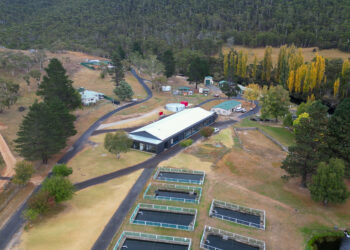THE aquatic ecology staff at the Arthur Rylah Institute, part of the Victorian Department of Environment, Land, Water and Planning, have been busy in the field in March. Multiple teams have been out and about in eastern Victoria surveying fish including:
-

Juvenile black bream were found to be plentiful near the structure in the estuarine reach of the Mitchell River. the estuarine reach of the Mitchell River, an area that is popular with recreational fishers. The East Gippsland CMA has been busy installing instream habitat (i.e. snags) within the reach. These surveys will help identify the extent to which the structures have improved fish numbers and dispersal through the reach. The surveys will also guide where any future instream structure would best be placed to maximise its value to fish. As the surveys were only conducted in recent weeks, data has yet to be analysed. Observations at the time of the survey, however, suggest that juvenile black bream are at present plentiful in areas associated with the instream structure, indicating good recent recruitment of the species to the system. Installation of the snags was funded by the Victorian State Government through the Recreational Fishing Grants Program and aligns with the Water Plan, Water for Victoria, which provides for long term investment in waterway health that also improves the recreational value of our rivers.
-

Recent surveys of the tributaries of the Gippsland Lakes in Victoria even revealed a seahorse! the estuarine reaches of the tributaries to the Gippsland Lakes, for the Index of Estuarine Condition assessment (IEC). The IEC will report on condition of estuaries across the State in 2020 and will assist in prioritising management and providing a baseline for assessing long-term changes in estuary health. The current IEC assessment which began in 2016, is looking at fish, fringing vegetation, submerged vegetation (seagrass and macroalgae), and water quality. The survey last week found recreational fish species such as dusky flathead, luderick, bream, estuary perch, tailor, mullet, garfish, and juvenile salmon and King George whiting. We also recorded smaller bodied species such as hardyhead, gobies, flat-headed gudgeons, galaxiids (minnows) and even pipefish and a seahorse. Unfortunately, we also observed large numbers of carp in some areas. This work is funded by DELWP Water and Catchments, and is part of a $222 million investment by the Victorian Government announced in the Water Plan, Water for Victoria, to improve the health of waterways and catchments. The IEC will play an important role in supporting the government’s commitment to improving knowledge and information about waterways and providing better reporting back to communities.
-

Surveys of the Thomson River as part of the Native Fish Report Card Project revealed Australian bass. the Thomson River as part of a Native Fish Report Card project. This project, which began in 2016, is like the Victorian Fisheries Authority’s Wild Trout Management Program, which is well received by recreational anglers. The project aims to assess and evaluate the status of priority fish species, including recreational and high value fish species in priority rivers, produce report cards to share the results and support fisheries and waterway management. Regular surveys are undertaken to increase our understanding of fish populations (e.g. indicators based on the abundance, size classes, and recruitment, of fish). The project will inform the status and trends of fish species, and will contribute to the identification of issues that are worthy of more intensive investigation. The recent survey found Australian bass, with lots of very small fish (i.e. Native Fish Report Card program information on the VFA website for more details. This work is jointly funded by DELWP Water and Catchments and the Victorian Fisheries Authority.
















